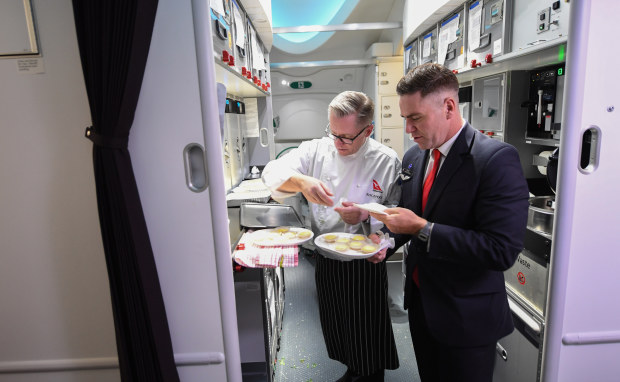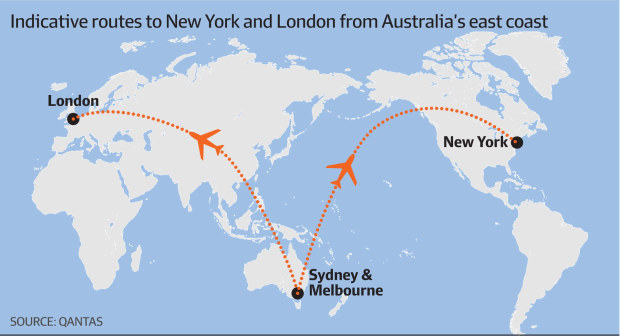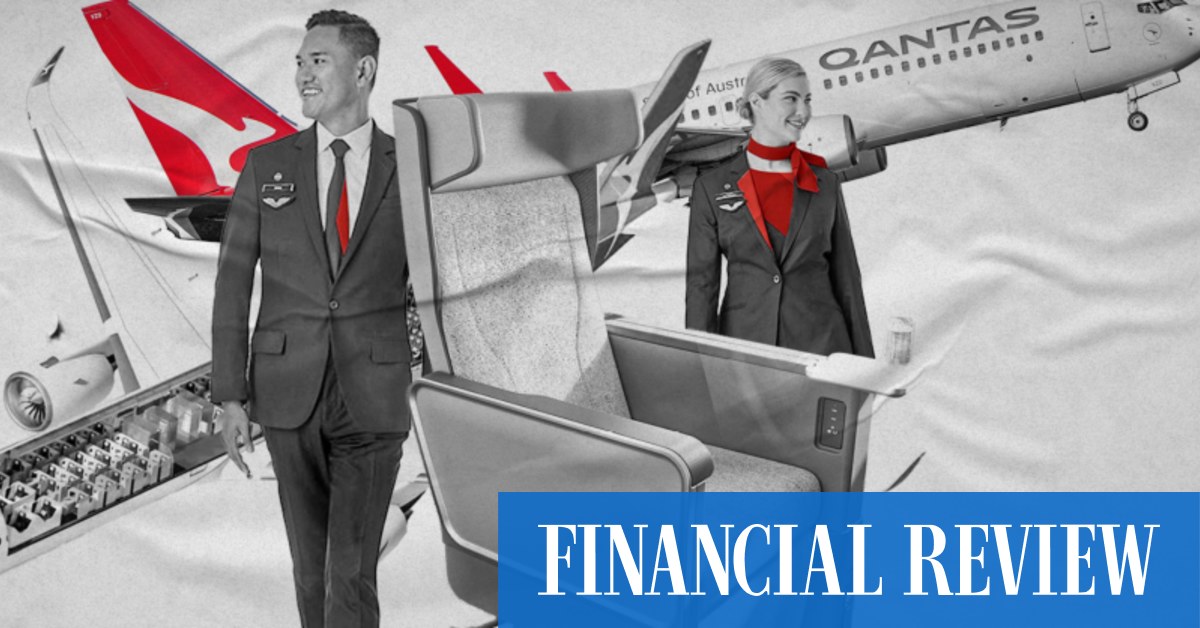Ian Hosegood is Qantas’ chief medical officer. He says the entire in-flight experience has been redesigned to emphasise sleep, entertainment and better meals. On shorter flights, the only requirement is a comfortable seat. As flight length grows, rest and sustenance become more and more important.
“With ultra-long range, we then start to think about not only prolonged rest and sleep, but also around body clock management and shifting to the destination time zone,” says Hosegood.
Extra space, free Wi-Fi: Economy class seats on board Qantas’ Airbus A350.
Qantas has made much of upgrading its aircraft cabins, with more first-class options and roomier economy seats.
Chris Chamberlin, a news editor at Point Hacks, a platform that lists frequent flyer deals, took a trip to Hamburg to try out the new economy section. He says he was pleasantly surprised.
“Qantas’ version takes [manufacturer] Recaro’s most comfortable padding option – and I have to say, it’s noticeably better than a normal seat. Sitting in a standard seat, and then moving to the Qantas version, really makes the difference stand out,” he says.
“I like the space-saving features that maximise legroom. For one thing, the tray table isn’t large and bulky: it folds out in half size and then expands. It sits above your legs – not at knee height – which makes the seat more spacious. Even when the passenger in front fully reclines, the seat doesn’t touch your legs.”

One of Qantas’ first test flights for Project Sunrise, from Sydney to London. The airline hopes to begin commercial services in 2026. Getty
The seat was a bit more “squeezy”, says Chamberlin, although Qantas will use a wider arm rest than the version he sampled.
“The challenge with Project Sunrise is finding enough economy passengers who’ll be happy to go up to 20 hours without properly stretching their legs. In my book, when flying long-haul down the back, I’d much rather stop somewhere along the way – Asia or the Middle East on the way to Europe, for instance – to rest up, walk around and prepare for the next stage of the journey,” he adds.
“Time will tell whether these non-stop flights are comfortable enough to become the preferred way to fly.”
Convincing the crew a challenge
Two groups that are viewing Project Sunrise with a dose of scepticism are the pilots and the crew. They want to be sure that the $400 million in savings Joyce spoke of wouldn’t come from them. Navigating this will be tricky for Hudson.
“I’d be interested in understanding where they’re going to make these savings,” says Flight Attendants Association of Australia president Terri O’Toole. “If I just look through my lens, I’d say landing rights cost a fortune. Direct flights save on those costs, but I don’t know where they think they’re getting all the other savings.”
The threat of offshoring more cabin crews, as Qantas has done on its Auckland-New York flights, looms large.
“The only major saving for cabin crew would be to offshore it. The idea to make the Spirit of Australia the Spirit of New Zealand, Singapore or London? We’re saying put your money where your mouth is Vanessa, prove your words with actions,” O’Toole says.

Crew on board Qantas’ first Project Sunrise test flights in 2019.
For pilots, it is even more complicated. Australian and International Pilots Association president Tony Lucas says like cabin crew, the length of Sunrise operations means they’ll need a variation to long-haul agreements that mean no pilot can be at the controls for more than eight hours during a flight.
“When they started flying 17 hours from Perth to London, we made that work, we’re doing Auckland to JFK, which is longer. You can keep adding on only half an hour ad infinitum, but at some stage you’re going to reach a point where that doesn’t work,” he says.
“Twenty-hour flights come with a very different level of fatigue and after operating all that time, our preferred model is that we operate with three pilots who are qualified to land the plane.”
While the current composition for 19-hour flights to Dallas Fort Worth involves having two second officers – who can’t land or take off – alongside one first officer and a captain (who can), Hosegood, Qantas’ chief medical officer, says Sunrise will, at least initially, involve a “more conservative” approach.
Talks are now afoot with pilots, Qantas and the Civil Aviation Safety Authority over the best way to manage pilot fatigue and ensure safety. Hosegood conceding that this is likely to be in the form of the pilots’ preferred model at the start.
But part of Qantas’ plan is to start flying long-haul routes before refining the complement of pilots.
“We’ll be demonstrating to the regulator that it’s safe and that there isn’t some magical thing that happens at 20 hours that doesn’t happen at 19 hours. We very much believe that there’s not going to be any very significant difference,” says Hosegood.
“In fact, we will likely see similar – if not better – fatigue outcomes given the amount of effort we’re doing to tailor the flights and the rest facilities.”
Cam Wallace says Qantas “already operate some of the longest flights in the world, so we have a lot of experience in how to best support our crew and customers on these ultra-long-haul flights”.
Stopover savings
Vanessa Hudson says Qantas is making more money on its Perth to London service than any other flight in its network, with travellers preferring not to stop overseas when possible.
One former Qantas executive, who spoke to AFR Weekend on condition of anonymity, says most of the $400 million in savings comes from avoiding the stopover – and associated landing fees – as well as reduced fuel burn from take-offs and landings.
The new aircraft are also much more fuel efficient, and with fewer take-offs and landings, maintenance events – which are measured by each cycle – are much fewer and further between.
“But you’re also cutting out competition because no other airlines need those planes for flights other than to Australia, making it far less likely any of them will invest to challenge Qantas,” the former executive says.
For now, the A350-1000 ULR remains in development at Airbus and is not immune to the delays plaguing airlines worldwide.

While the third fuel tank required by Qantas has been certified, Emirates president Tim Clark provided an insight into just how far away its Rolls-Royce engines are from meeting standards.
Sir Tim told reporters that Rolls-Royce had presented Emirates with engines that last 500 cycles – or 500 take-offs and landings – rather than the 2500 cycles needed to be considered economical.
The difference in terms of useful life goes from four years to just eight months, although the extreme heat and dust in Emirates’ home airports present a bigger challenge than the one facing Qantas.
Qantas’ Wallace admitted Qantas had spent the weekend in Dubai talking to Rolls-Royce about “making sure we get the best, optimal solution” out of the engines, which it will also use for Sunrise.
“We’ve got a couple of years to go,” Wallace says.

